Advancements in Unmanned Combat Air Vehicles: Introducing Gambit 6
Overview
On November 4, 2025, General Atomics Aeronautical Systems, Inc. (GA-ASI) unveiled the latest model in its Gambit Series of unmanned combat air vehicles (UCAVs): the Gambit 6. This innovative collaborative combat aircraft (CCA) enhances the air-to-air capabilities previously established in earlier models by incorporating robust air-to-ground operational functionality. With its cutting-edge design, Gambit 6 is poised to meet diverse demands in electronic warfare, suppression of enemy air defenses (SEAD), and precision strike missions.
A Global Response to Emerging Threats
Armed forces globally are increasingly seeking air-to-ground-capable CCAs capable of adapting to rapidly changing operational landscapes and confronting threats in contested environments. Gambit 6 has been meticulously engineered to fulfill this requirement for flexibility, scalability, and mission-specific performance.
David R. Alexander, President of GA-ASI, emphasized the strategic imperative: “These are tangible threats demanding substantive solutions. The Gambit 6 features a modular architecture and a signature-reducing internal weapons compartment, facilitating seamless integration of next-generation autonomous capabilities, advanced sensors, and weaponry.”
Timeline for Deployment
- International Procurement: Airframes are slated for worldwide acquisition beginning in 2027.
- European Variants: Specialized missionized models designed for European operational contexts are expected to be operational by 2029.
- Partnership Development: GA-ASI is actively cultivating industry collaborations across Europe, focusing on delivering sovereign capabilities across all its platforms.
Modular Design for Enhanced Operational Efficiency
The Gambit Series is envisioned as a modular family of unmanned vehicles, allowing multiple CCA variants to be swiftly reconfigured from a unified core. This strategy promotes significant commonality, facilitating rapid, cost-effective production at scale.
Key Features of the Gambit Series:
- Broad Mission Profile: Capable of fulfilling various roles, including intelligence, surveillance, reconnaissance, multi-domain combat, advanced pilot training, and stealth reconnaissance.
- Common Core Platform: A shared infrastructure across models, encompassing landing gear, baseline avionics, and chassis to streamline costs, enhance interoperability, and accelerate derivative development.
Customized Solutions for Complex Missions
Through specialized configurations and sophisticated autonomy, the Gambit platforms deliver tailored capabilities, improving operational efficacy, reducing expenses, and enhancing survivability in hostile environments. One notable derivative is the U.S. Air Force’s YFQ-42A, crafted as part of its initiative to deploy AI-enabled uncrewed wingmen. This platform, which builds on the Gambit 2 framework, is designed to augment crewed fighters, such as the F-35 and Next-Generation Air Dominance (NGAD) systems, thereby boosting sensing, munitions capacity, and durability in challenging airspace.
Evolution of Gambit Technologies
The Gambit series originated with an ambitious concept introduced three years ago, featuring four foundational models:
- Gambit 1: A versatile sensing platform designed for extended endurance.
- Gambit 2: An enhanced model integrating provisions for air-to-air weaponry.
- Gambit 3: Geared towards complex adversary engagement with optimized configurations.
- Gambit 4: Focused on combat reconnaissance, characterized by a tail-less design and swept wings.
In 2024, GA-ASI expanded the series with Gambit 5, specifically adapted for naval operations.
The Gambit 6 represents a significant leap forward in the realm of unmanned combat air vehicles, addressing pressing defense needs while setting the stage for sophisticated future capabilities.





